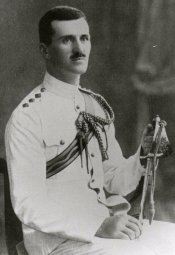William Henry Johnston facts for kids
Quick facts for kids
William Henry Johnston
|
|
|---|---|
 |
|
| Born | 21 December 1879 Leith, Edinburgh, Scotland |
| Died | 8 June 1915 (aged 35) St. Eloi, Belgium |
| Buried |
Perth Cemetery (China Wall)
|
| Allegiance | |
| Service/ |
|
| Years of service | 1899–1915 † |
| Rank | Major |
| Unit | Royal Engineers |
| Battles/wars | World War I |
| Awards | Victoria Cross |
William Henry Johnston (born December 21, 1879 – died June 8, 1915) was a brave British soldier. He received the Victoria Cross, which is the highest award for courage a soldier can get in the United Kingdom and Commonwealth countries. It's given for amazing bravery when facing the enemy.
Contents
Early Life and Military Service
William Henry Johnston was born in Leith, Edinburgh, Scotland, on December 21, 1879. His parents were Major William Johnston and Mary Johnston. He joined the British Army and became a captain. He served in the 59th Field Company of the Corps of Royal Engineers. The Royal Engineers are a special part of the army. They are known for their engineering skills, like building bridges or digging tunnels.
A Heroic Act in World War I
Johnston was 34 years old when World War I began. On September 14, 1914, he showed incredible bravery in France. This happened during a period of the war called the "Race to the Sea." At a place called Missy, he worked tirelessly under heavy enemy fire.
He used two rafts to help his fellow soldiers. He brought wounded soldiers back to safety. Then, he returned with ammunition for the soldiers still fighting. He did this all day, until 7 p.m., even though bullets were flying everywhere. Because of his actions, an advanced group of British soldiers could hold their position across the river. This brave act earned him the Victoria Cross.
His award was officially announced in The London Gazette on November 25, 1914. The announcement praised his courage and dedication.
Life in the Trenches and Final Days
After his heroic act, Johnston continued to serve with the tunnelling companies of the Royal Engineers. These companies were very important during World War I. They dug tunnels under enemy lines to place explosives or to create secret passages. Johnston worked at a place called St. Eloi, which was part of the Ypres Salient in Belgium.
Mining activity by the Royal Engineers started at St. Eloi in early 1915. The German army also dug tunnels and exploded mines. In March 1915, the Germans blew up mines under an area called The Mound. This led to fierce fighting, and the British suffered many casualties. A month later, in April 1915, the Germans exploded another mine. It created a huge crater, more than 20 meters (about 65 feet) wide.
Captain Johnston commanded the 172nd Tunnelling Company in early 1915. He left this company in early May. Sadly, he was killed in action near Ypres on June 8, 1915. He had been promoted to the rank of major before his death.
Legacy
Major William Henry Johnston's Victoria Cross is a symbol of his bravery. It is now on display at the Royal Engineers Museum in Chatham, Kent, England.

